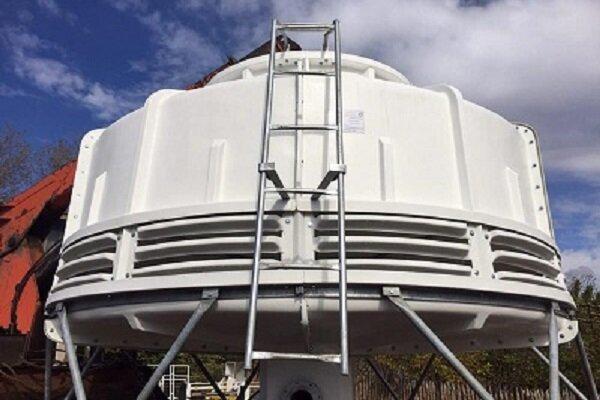Cooling Tower Selection Tips
Read on to find the answers to your questions on price, technical specifications, and the best cubic and round cooling towers on the market.
Broadly speaking, the cooling tower is tasked with cooling the water circulating the condenser in air conditioning systems, industrial processes, power plants, refineries, and other industries.
The tower cools down the circulating water based on heat transfer via mass transfer, providing sufficient surface area for heat exchange between the water entering the tower and the air passing through, as well as slowing down the descending water by packings or other media (such as boards).
When selecting the cooling tower capacity, note that the maximum temperature difference between the input and output must be less than the difference between the input water temperature and the ambient Wet-Bulb Temperature (WBT). In other words, the minimum temperature of the cooling tower output must be more than the WBT in the space where the equipment is installed. On the other hand, the lower the humidity of the air where the cooling tower is installed, the lower the ambient WBT, helping provide colder output water.
Cooling towers can be categorized from different aspects as follows:
Appearance (bottle, cubic)
Air intake (natural, forced)
Working mechanism (open-circuit, closed-circuit)
Casing material (galvanized steel, fibreglass, concrete)
Air and water flow arrangement (cross-flow, counter-flow)
Distribution of water (nozzle, water basin, water circulation arm)
Open-Circuit Cooling Tower The open-circuit cooling tower is, in fact, your typical cooling tower integrated into an air conditioning system that cools down the working fluid by spraying it over packings—that increase the air-water contact area—and collecting it in a basin at the bottom to be pumped back to the AC system.
Closed-Circuit Cooling Tower This type of tower cools the circulating water by spraying it over packings exposed to flowing air. In contact with the coil running the working fluid (water, oil, or else) in a closed-circuit, the sprayed water cools it down (closed-circuit cooling towers are much more expensive than their open-circuit counterparts due to integrating such equipment as heat-exchange coils and pumps).
Estimating The Cooling Tower Make-Up Water
The normal loss of water in cooling towers can range between 0.2 and 0.3 lit/min per nominal ton of refrigeration (it must be noted that the loss of water depends on several factors including the relative humidity of ambient air, ambient temperature, and the temperature difference between the entering water and the ambient air).
Fiberglass Cooling Tower Selection Tips
Being located in an outdoor space and exposed to direct sunlight, cooling towers are required to be protected by a Neo Penta Glycol (NPG) Gelcoat finish to prevent UV destruction.
Further, with all the internal components of the tower in constant contact with water, they must be made of stainless or galvanized steel to keep the structural and other components (including screws and bolts) from rusting.
The cooling surfaces (packings) in the cooling tower must be of suitable design and material. Packings are often made of antimicrobial grade, 400 micron PVC or PP sheets.
The fan must be both statically and dynamically balanced to extend the service life of the electric motor and reduce the noises generated by it during the start-up.
When placing an order for high-capacity cooling towers, it is best to use a transmission system equipped with a gearbox.
Installing a ladder to access different parts of a large-scale tower, including the electric motor, is essential for maintenance.
In air conditioning systems, the water enters the tower (from the vapor compression chiller) at 33–35 °C and leaves it for the condenser at 28–30 °C. In other words, the range (the difference between the entering water temperature and the leaving water temperature) is approximately 4–6 °C.
The multi-stage thermostat: by installing a multi-stage thermostat at the cooling tower outlet to the chiller condenser, the temperature of the water leaving the tower (for the condenser) can be controlled by adjusting the slow-opening thermostat and changing the speed of the electric motor according to the command transmitted to the inverter.
In cases without a smart control system, it is necessary that at least one thermostat capable of commanding the fan motor to stop/start is installed on the cooling tower output line to the collector for times when the weather is moderate to offer further control over the temperature of the water leaving the tower.
In case of requiring consultation on the selection, calculation, and purchase of cooling towers contact our sales specialists at DamaTajhiz.
Under the Cooling Towers category at DamaTajhiz.com—the first (from 2005) and largest online retailer for heating and cooling equipment in the Middle East (according to Alexa.com)—you can easily find a product that fits your requirements at the best price (best price guarantee) by browsing through the comprehensive descriptions provided, assured to receive original services and warranties.
When Handling or Installing The Cooling Tower Equipment, Note That...
If the fibreglass cooling tower has a diameter of over 220 cm, it is recommended to transport the equipment to the project location in pieces to prevent damages to the cooling tower. Needless to say, in this case, the re-assembly of the cooling tower will incur additional charges.
The cooling tower chassis must be designed proportionately to the exact weight and dimensions of the tower to be capable of supporting it according to the structural conditions of the building, all the while remaining discrete not to undermine the appearance of the building.
If using a crane at the project site is not possible for handling the equipment, make sure not to place an order for a pre-assembled cooling tower.
Basically, the cooling tower must be installed in a location where nothing bars fresh air from flowing into the equipment. Further, if multiple towers are used in tandem, the configuration must be designed not to allow the output air of one tower to enter another directly and reduce the efficiency of the system. With the suitable cooling tower capacity determined, if the equipment can be installed in outdoor space, exposed to open air, attaining an acceptable efficiency is not challenging. However, should the cooling tower be installed indoors or surrounded by walls, the following must be satisfied:
a) the tower must be given enough space for fresh air to reach it without restriction.
b) the humid cooling tower output air must be exhausted in a way that ensures it cannot return and recirculate the tower as it will increase the WBT, keeping the water circulating the system from cooling down.
Placing an Order and Warranties for Cooling Towers
Offering the best price guarantee for all products, the prices for all cooling tower equipment presented by DamaTajhiz are up-to-date and discount-included (see Best Price Guarantee at DamaTajhiz.com).
Find the information you need for comparison and purchase, as well as unbeatable prices, for hundreds of models of cooling towers with original warranties from reliable manufacturers at DamaTajhiz.com, under the Cooling Towers category.
This article is an advertisement and Mehr News Agency has no opinion on its content.
News source: Mehr News ![]()
Related news: Cooling Tower Selection Tips
Copyright © 2001-2024 - Sarkhat.com - About Sarkhat - News Archive - جدول لیگ برتر ایران

